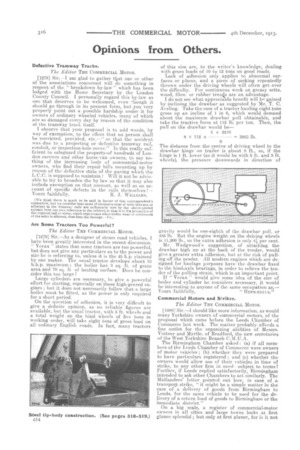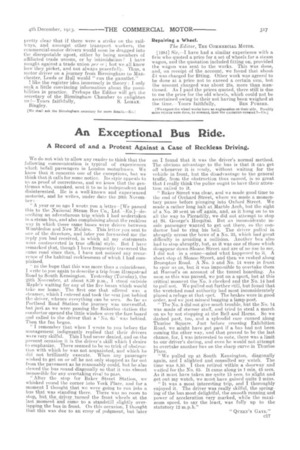Opinions from Others.
Page 16

Page 17

If you've noticed an error in this article please click here to report it so we can fix it.
Defective Tramway Tracks.
The Editor THE COMMERCIAL MOTOR.
[1278] Sir,—I am glad to gather tat one or other of the associations concerned will do something in respect of the " breakdown by-law" which has been lodged with the Home Secretary by the London County Council. I personally regard this by-law as one that deserves to be welcomed, even though it should go through in its present form, but you very properly point out a possible hardship under it. for owners of ordinary wheeled vehicles, many of which are so damaged every day by reason of the condition of the tramway track itself.
I observe that your proposal is to add words, by way of exemption, to the effect that no person shall be convicted, provided, etc.—" or that the accident was due to a projecting or defective, tramway rail, conduit, or inspection-hole cover." Is this really sufficient to safeguard the property.of hundreds of London carriers and other horse-van owners, to say nothing of the increasing body of commercial-motor owners, who find their repair bills mounting up by reason of the defective state of the paving which the L.C.C. is supposed to maintain i Will it not be advisable to try to broaden the by -law so that it may also include exemption on that account, as well as on account of specific defects in the rails themselves ?--- Yours faithfully, R. J. WILLIAMS.
[We think there is much to be said in favour of this correspondent's contention, but we consider that cases of excessive wear of setts between or adjacent to the tramwayrails are sufficiently met by the above-tooted extract from our own reference to the subject, in that it is the projectkm of the exposed rail or cover' which supervenes when undue wear or settlement of the Betts is allowed, that does the damage—End Are Some Tractors Too Pow2rl'ul ?
The Editor THE COMMERCIAL MOTOR.
[1279] Sir,—As a designer of steam road vehicles, I have been greatly interested in the recent discussion. " Iterax states that some tractors are too powerful, but does not give any particulars as to the power and size he is referring to, unless it is the 45 h.p. claimed by one maker. The usual tractor develops about 33 b.h.p. maximum ; the boiler has 3 sq. ft. of grate area and 70 sq. ft of heating surface. Does he consider this too large ?
Large cylinders are necessary, to give a powerful effort for starting, especially on these high-geared engines ; but it does not necessarily follow that a large boiler must be. fitted, as the power is only required for a short period.
On the question of adhesion, it is very difficult to give a definite opinion, as DO reliable figures are available, but the usual tractor, with 5 ft. wheels and a total weight on the hind wheels of five tons in working order, will take eight tons of gross load on all ordinary English roads. In fact, many tractors
of this size are, to the writer's knowledge, dealing with gross loads of 10 to 12 tons on good roads. Lack of adhesion only applies to abnormal surfaces or places, and a piece of sacking repeatedly thrown under the driving wheels will often get over the difficulty. For continuous work on greasy setts, wood, fibre, or rubber treath are an advantage. I do not see what appreciable benefit will be gained by inclining the drawbar as suggested by Mr. T. C. Aveling. Take the case of a tractor hauling eight tons gross up an incline of 1 in 6, which would demand about the maximum drawbar pull obtainable, and take the tractive force at 112 lb. per ton. Then, the pull on the drawbar would be 8 x MC) 8 x 112 + — 3883 lb.
The distance from the centre of driving wheel to the drawbar hinge on trailer is about 8 ft., so, if the hinge is 1 ft. lower (as it would be with 5 ft. and 3 ft. wheels), the pressure downwards in direction of
gravity would be one-eighth of the drawbar pull, or 485 lb. But the engine weight on the driving wheels is 11,200 lb., so the extra adhesion is only 4 per cent.
Mr. Wedgwood's suggestion, of attaching the drawbar high UT/ at the back of the tender, would give a greater extra adhesion, but at the risk of pulling off the tender. All modern engines which are designed for haulage purposes have the drawbar fixed to the hitaLaxle bearings, in order to relieve the tender of the pulling strain, which is an important. point.
If " Yerax " would give some idea of the size of boiler and cylinder he considers necessary, it would be interesting to anyone of the same occupation as,— '` HEPSITS."
Yours faithfully, ILE
'` HEPSITS."
Commercial Motors and Strikes.
The Editor THE COMMERCIAL MOTOR.
[1280] should like more information, as would many Yorkshire owners of commercial motors, of the proposal which came before the Leeds Chamber of Commerce last week. The matter probably affords a fine outlet for the organizing abilities of Messrs. Vintner and Myrtle, of Bradford, the new secretaries of the West Yorkshire Branch C.M.U.A.
The Birmingham Chamber asked : (a) if all members of the Leeds Chamber of Commerce were owners of motor vehicles ; (b) whether they were prepared to have particulars registered ; and (c) whether the owners would allow use of their vehicles in time of strike, to any other firm in need--subject to terms ? Further, if Leeds replied satisfactorily, Birmingham intended to ask other Chambers to act similarly. The Midlanders' letter pointed out how, in case of a transport strike, "it might be a simple matter in the case of a delivery of goods from Birmingham to Leeds, for the same vehicle to be used for the delivery of a return load of goods to Birmingham or the immediate district."
On a big scale, a register of commercial-motor owners in all cities and large towns looks at first glance splendid ; but only at first glance,. for is it not
pretty clear that if there were a, strike on the railways, and amongst other transport workers, the ceinmercial-motor drives would soon be dragged into the, disreputable upset, either by being members of affiliated trade unions, or by intimidation ? I have nought against a trade union per ye ; but we all know how they picket, and not always peacefully. Thus, a motor driver on a journey from Birmingham to Manchester, Leeds or Hull would run the gauntlet."
I like the register idea immensely in theory : I only seek a little convincing information about the possibilities in practice. Perhaps the Editor will get the secretary of the Birmingham Chamber to enlighten usl—Yours faithfully, S. LOMAX. Bingley.
[We shall ask the Birmingham secretary for mare detaiIs.-ED.]
Repairing a Wheel.
The Editor, THE COMMERCIAL MOTOR.
[1281] Sir,—I have had a similar experience with a firm who quoted a price for a set of wheels for a steam wagon, and the quotation included fitting on, provided the wagon was sent to the works. This was done, and, on receipt of the account, we found that about £4 was charged for fitting. Other work was agreed to be done at a price not to exceed a certain sum, but the amount charged was about 25s. more than mentioned. As I paid the prices quoted, there still is due to me the price for the old wheels, which could not be ascertained owing to their not having been weighed at the time.—Yours faithfully, BEN PURSER.
(We expect the wheel works have an explanation on their side. Possibly more repairs were done, by consent, than the quotation covered ?—men.1
























